OUR NATURAL RESOURCES
Wild Things
By LIZ PENSONEAU
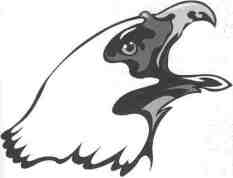
It is against the law to have a wild animal
in your possession without a permit.
|
The wildlife comes from throughout Illinois,
arriving at Urbana-Champaign all hours
of the day and night. Some are injured and
require immediate medical attention; others
have been orphaned and are malnourished.
All have special needs that can only be understood
and met by people with the knowledge and
skills to treat injured wildlife.
Such skills are not only practiced, but
also taught at the University of Illinois'
Wildlife Medical Clinic. Last year, student volunteers from
the school's College of Veterinary Medicine, working under the
guidance of Dr. Thomas Burke and Dr. Kenneth Welle,
treated more than 1,200 raptors
and other native animals that were either
brought or referred to them by the general public, licensed wildlife
rehabilitators or veterinarians.
|
The facility itself is part of the
university's Small Animal Clinic. The university provides the space and equipment for the clinic, while public donations fund the treatment of injured animals. The clinic is staffed
by veterinary students, who volunteer their
time in exchange for knowledge of emergency medical treatment for wildlife, handson experience and the overall satisfaction of
making a contribution to the welfare of native animals.
One such individual is Julie Towie, a third year medical student who has volunteered
at the clinic since 1995. Towie and second
year student Darlene Berkovitz currently
manage the clinic and serve as consultants
to fellow students. Their other duties include
the stocking of supplies, the ordering of food
and the review of case records to make sure
all treatment meets high standards. All volunteers assists with housekeeping duties.
According to Towie, there are 50 student
volunteers this semester. Typically, more than
half of the members of each class work at
the clinic in order to gain important experience in the handling and care of wildlife
experience that is needed for successful rehabilitation. All students are assigned to a
specific animal or raptor, known as a "case,"
and are responsible for all aspects of its daily
care and medical treatment.
"We tell the students one of the best ways
to assess the condition of their case is to weigh
the animal because you can't always tell by
observing it. Quite often, an animal, especially a wild animal, instinctively behaves as
if it is healthy to avoid predation. By keeping track of an animal's weight, you can more
accurately monitor its progress."
Liz Robertson, a second semester freshman says she thinks volunteering her time is
well worth it. "Working at the clinic incorporates a lot of what we are taught in class
where you can't see or touch or feel," she
said. "I've gotten a lot out of the experience."
May/June 1998/ 49
OUR NATURAL RESOURCES
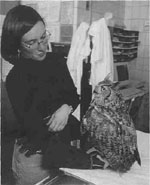
|
Natalie Mylniczenko, a student at
the U of I College of Veterinary
Medicine, tends to a great horned
owl with a fractured wing. Owls
frequently get hit by cars and
tangled in power lines.
|
Robertson's own case assignment, a very
aggressive opossum, was recovering from a
broken elbow. She was preparing to take him
to the flight cages to get him acclimated for
release into the wild. Occupying other cages
were a screech owl, a red-tailed hawk with a
broken wing, a great horned owl, a short-
eared owl, a red-tailed owl with a wing injury, a domestic goose with an eye problem,
a fox that had been caught in a leg-hold trap,
an opossum that had emergency abdominal
surgery and an American Kestrel. All were
housed in immaculate cages in the Cage
Room, with the exception of the surgical
patient (the opossum), which peered out
from an incubator.
The cages are cleaned and washed down
each day and then lined with newspapers by
the team of students assigned to each animal. Many of the doors to the cages are covered with cloth or newspaper to cut down
on the stress level that might be derived from
all of the activity that goes on outside the
cages. Towle explained that each team is required to do a status report on its animal at
least once each day.
"We call the report a SOAP," she said. "'S'
meaning subjective; '0' objective; 'A' assessment of case; and 'P' progress notes and
plan," said Towle.
Occasionally, the nature of an injury will
prevent the release of rehabilitated wildlife.
With the proper permits, such wildlife can
be used for educational purposes. For example, a screech owl is used by the Wildlife
Medical Clinic to present programs to various students, groups and organizations. Education Coordinator Rose Ann Meccoli, with
the help of a few veterinary students, presented 53 such educational talks last year to
more than 6,500 people to raise the overall
level of public awareness about wildlife.
"We have found that, at the school level,
it is very effective to pass out pamphlets and
talk to children about rescuing wildlife,"
Towle said. "Oftentimes, it is the children
who pass the information along to their parents."
Towle explained that most of the animals
at the clinic are brought in by the general
public and that the clinic works closely with
several wildlife rehabilitators who bring in
cases for medical care. "Usually when we are
finished treating an animal, we will take it
to a rehabilitator to get it in flight condition
and back to the wild," she said. "The average stay at the clinic is one or two days; however, the visit can turn into weeks or even
months, depending upon the injury. Some
wildlife are so severely injured that they must
be euthanized."
Towle stressed that the purpose of the
clinic is to provide medical treatment and
prevent suffering. Initial examinations determine if an animal has a reasonable expectation of survival or if the injuries are so severe
that they would result in prolonged pain and
suffering. Animals and birds in the latter
category are humanely euthanized.
"The veterinarian oath actually says to prevent suffering, not to always prolong the life
of the animal," Towle said. "So, we operate
in accordance with that oath."
50 / Illinois Parks and Recreation
OUR NATURAL RESOURCES
For animals that are releasable, the clinic
tries to get them out to area rehabilitators
that have groups of young animals. That way,
the animals can be raised as a group and released as a group. Successful wildlife
rehabilitators realize that human contact with
native wildlife needs to be minimized, as the
goal of rehabilitation is to release animals
back to their natural habitat. For such releases to be effective, wildlife must be able
to function in their natural environment.
This includes being able to recognize and
obtain the appropriate foods, select mates of
their own species and demonstrate appropriate fear of potential dangers, including
people.
Towle said the Wildlife Medical Clinic is
open 24 hours a day and offers emergency
service. Injured wildlife can be brought to
the Small Animal Clinic, Room 150, 1008
Hazelwood Drive, Urbana, 217.333.5300.
Calls directed to the wildlife ward, 217.
244.1195, will reach an answering machine.
Callers are asked to leave a message and a
phone number where they can be reached.
"Callers should leave a message and be patient," Towle said. "We will get back to them as soon as possible."
Doing What Is Best
With the onset of spring migration, many
birds will fracture wing bones as they fly into
high tension wires. In addition, automobiles
and other man-made equipment will be responsible for many injuries to mammals.
Orphaned baby animals will be found, and
environmental problems will also take a toll
on wildlife. Chances are good that you might
come across injured wildlife or wildlife that
appears to be orphaned. If so, what should
you do?
Abandoned or Home Alone?
Don't be alarmed if you find a baby animal home alone this spring or summer. Wild
animals are excellent mothers, but they must
leave their young alone while they forage for
food.
Oftentimes, the mother will be gone all
day, so the young wildlife will appear to be
abandoned when it actually is not. It is best
to leave the animal alone and let nature take
its course.
Good Advice
The Wildlife Medical Clinics Orphan
Care Committee offers sound advice on this
subject in its brochure, "Orphan Wildlife:
How to help without hurting."
It states: "Many of the animals that are
brought to the WMC in the spring and summer are healthy, young animals that are presumed to be orphaned. In reality, most of
these wild babies have not been abandoned.
Since natural mothers provide far better care,
nutrition and survival training than the best
trained wildlife rehabilitator, it is important
to be certain that an animal is abandoned
before removing it from the wild.
"It is also important to remember that
death is an integral part of nature. Small
mammals and birds produce many offspring,
but only a handful survive to adulthood. If
an animal is not strong enough, or has a congenital defect, nature selects it out of the
population for the benefit of the entire species. This is what enables a species to adapt
to the changes of the environment in which
it lives."
Old Wives Tale
The brochure also explains it is merely an
old wives tale that a bird or mammal will
abandon a nest or not accept its baby back
after a human has touched it. So if a baby
bird has fallen from its nest, do not hesitate
to put it back.
When Help Is Needed
Signs that a wild baby is abandoned and
in need of help could include a dead parent
or sibling found nearby or a listless, cold or
emaciated baby. If the wildlife does need assistance, use a towel or sheet to carefully pick
it up and place it in a secure padded and
ventilated box.
Do not attempt to care for it yourself. If
an injured animal is a threat to public safety,
an animal control officer or a wildlife rehabilitation center should be contacted immediately for assistance.
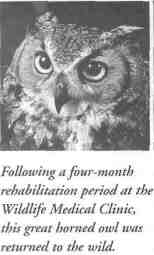
|
Don't Go It Alone
Federal laws prohibit care of wildlife by
anyone other than licensed rehabilitators. In
addition to being against the law to have such
animals in your possession without a permit, it is difficult to simulate their diets. An
inadequate diet for wildlife can be fatal to
the young animal. Bread can cause the death
of baby birds, and cows' milk can be very
harmful to other baby mammals. The names
of licensed wildlife rehabilitators can be obtained from any of the Department of Natural Resources' regional offices or by calling
its Division of Wildlife Resources at Springfield, 217.782.6384.
Copies of "Orphan Wildlife: How to help
without hurting" are available from the Wildlife Medical Clinic, University of Illinois,
2001 South Lincoln, Urbana, IL 61801.
Helpful information can also be found on
the facility's Web home page at http://
www.cvm.uiuc.edu/wmc/wmc.htm.
|
UZ PENSONEAU
is a staff writer for OutdoorIllinois, a publication of the Illinois
Department of Natural Resources-This article is reprinted with
permission from the April 1998 issue of OutdoorIllinois.
May/June 1998 / 51
OUR NATURAL RESOURCES NEWS BRIEFS
|
Illinois' Wildlife Rehabilitators
The Illinois Department of Natural Resources has licensed approximately 350
wildlife rehabilitators in the state of Illinois who provide temporary treatment
and care of injured and diseased native
wildlife, subsequently returning healthy
animals to appropriate habitats in the
wild.
Regulation of this program was established to ensure animal welfare, public health and safety, environmental protection and population protection.
Animal welfare-Nature intended
for wild animals to live in the wild. Individuals need special knowledge, skills
and facilities to responsibly handle,
treat and release rehabilitated wildlife to
ensure the welfare of both individual
animals and wildlife populations.
Public health and safety-Wild animals are known to carry a variety of diseases that can be transmitted to humans
and pets, so there is a need for the protection of public health and safety. Anyone handling wild animals needs to be
aware of the risks involved.
Environmental protection-is
needed to ensure that rehabilitated animals are not released in environmentally sensitive areas where the ecological balance can be disturbed by the intrusion of wildlife.
Population protection-to ensure
that only the proper number of healthy,
rehabilitated animals are released in a
given area. This is for the purpose of
maintaining a proper balance of the
wildlife population and preventing outbreaks of disease among the animal
populations in the release area.
For additional information, contact
the Illinois Department of Natural Resources, Division of Wildlife Resources,
524 South Second St., Springfield, IL
62701-1787, 217.782.6384. |
DNR Helps with Trail/Greenway
Planning
The Department of Natural Resources is
expanding its assistance to communities for
greenway and trail planning.
"This program is an extension of successful greenway and trail planning the Department assisted with in northeastern Illinois
and in other larger metropolitan areas," said
Ed Hoffman, manager of DNR's planning
division.
Hoffman said the goal of the program is
to assist communities and counties with
community and county-wide plans for the
protection of greenways and the development
of publicly accessible trails where appropriate.
The expansion is targeted at communities with a population of 10,000 or more,
non-metropolitan counties that have not participated in the earlier programs and coalitions that are interested in linking their trails
to trails in adjacent states.
The Department has provided a variety
of assistance for trail development, including funding of the Northeastern Illinois Regional Greenways Plan in 1992 and the Year
2000 Regional Greenways and Trails Implementation Program last year. It also is assisting with the development of trail plans in
10 larger metropolitan areas, with five plans
already completed, including Bloomington Normal, Peoria, Quad Cities, Rockford and
Springfield.
For more information, contact Jim Hart,
Greenways Program, DNR, 524 S. Second
St., Springfield, ILL. 62701-1787, or phone
217.782.3715.
52 / Illinois Parks and Recreation
OUR NATURAL RESCOURCES NEWS BRIEFS
Museum and Park District
Grants Announced
Twenty-four museums, aquariums, park districts and
conservation districts will share in more than $1.3 million
in grant funds generated from off-track betting parlors.
The grants are distributed from the Horse Racing Tax
Allocation Fund and will be used for general operating
support and capital improvements. In Chicago, the grants
are distributed to museums and aquariums. If a park district does not
Springfield Park District...................................$35,090.97
Rockford Park District....................................$58,062.62
Village of Richmond........................................$25,633.70
Waukegan Park District...................................$98,026.73
Fox Valley Park District ...................................$60,534.02
Bloomington Parks & Recreation Dept. ............$26,242.00
Carbondale Park District...................................$17,924.17
Champaign Park District....................................$19,144.85
Village of Crestwood .......................................$159,603.59
Vermilion County Conservation District.............$18,605.63
Effingham Park District....................................$10,028.49
Joliet Park District............................................ $64,212.76
Oakbrook Terrace........................................... $162,596.75
|
maintain a museum, the grant may be used for general purposes.
The grant program was authorized by the Horse Racing Act of
1987, which required that four/sevenths of 1 percent of
the tax revenue on receipts collected from inter-track wagering
locations be allotted for the grants. The Illinois Department
of Natural Resources distributes the proceeds twice a year.
Recipients include:
City of Peru ...................................................... $13,454.58
Grayville Park District ....................................... $16,920.20
Art Institute of Chicago...................................... $111,704.88
Field Museum of Natural History ...................... $111,704.88
Museum of Science & Industry.......................... $111,704.88
John G. Shedd Aquarium................................... $80,075.37
Adier Planetarium............................................... $34,581.59
Chicago Historical Society..................................$34,634.31
Academy of Science .......................................... $18,766.84
DuSable Museum of African Am. History ............ $12,282.79
Mexican Fine Arts Center Museum...................... $11,702.91
Total............................................................ $1,313,239.51
|
May/June 1998/ 53
OUR NATURAL RESOURCES NEWS BRIEFS
Service Proposes New Process To Control
Resident Canada Geese
The U.S. Fish and Wildlife Service has proposed establishing a new
permit to allow state agencies to deal with and control resident Canada
goose populations that pose a threat to public health and safety or are
damaging property.
Under the proposed new permit, between March 11 and Aug. 31,
states would not have to obtain individual permits from the Service
each time they determined that a Canada goose control action was
necessary, as is currently required. At other times of the year, states
would still have to seek permits on a case-by-case basis to ensure
these efforts do not interfered with effective regulation and monitoring of other Canada goose populations. The new permit would only
be available to state wildlife agencies.
The new permits would contain a certain number of conditions.
For example, states would be able to use lethal means of controlling
resident Canada goose populations only when alternative non-lethal
means have proven ineffective or unfeasible. States also would have
to set up the control actions in such a way that they are not actually a
"hunt" and would have to dispose of killed birds in a proper way,
such as donating them to charities to provide food for homeless people.
Control efforts include harassment, culling and trapping and relocating injurious flocks. States generally employ these means in areas
where reducing populations through hunting is not possible.
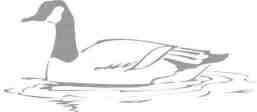
|
Wildlife agencies recognize and manage Canada geese by distinct
populations. The majority of these populations nest in the Arctic and
spend the winter in the United States; however, several populations
nest and reside in the temperate climates throughout the year and
often are referred to as "resident." While "migratory" and "resident "
birds look very similar and often intermingle, they rarely interbreed
nor do birds often shift from one population to the other.
The proposal focuses on resident Canada geese that live year-round
in the lower 48 states. These locally breeding birds have settled onto
golf courses, urban parks, corporate campuses and other protected
areas that offer excellent year-round habitat, both low in predators
and high in food supply.
The public may comment on the proposal in writing until June 1.
Comments should be sent to Chief, Office of Migratory Bird Management, 4401 N. Fairfax Drive, Arlington, Va. 22203.
|
|
New Changes in Effect for Boaters
As this year's boating season gets underway, Illinois
boaters should be aware of some changes in the
Illinois Boat Registration and Safety Act.
Changes that went into effect on Jan. 1
include:
• All persons under age 13 must wear
a flotation device while the boat is
underway, unless that person is be-
low deck or in a totally enclosed cabin
space. This requirement doesn't apply
to persons operating a watercraft on pri-
vate property. |
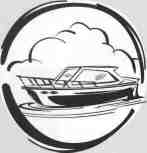
|
• No person operating a motorboat shall allow a
person to ride or sit on the gunwales, top of the seat
back or on decking over the bow or stern of the
boat while underway, unless the person is inboard of guards or rails provided on the boat
to prevent passengers from being lost overboard.
• Motorboats used for towing or assisting
a person on water skis, an aquaplane or
similar contrivance must have a capacity of
at least three persons.
The act also was amended to change the alcohol concentration to match the Illinois Vehicle
Code (.08) for purposes of arresting a person under the influence.
|
54 / Illinois Parks and Recreation




